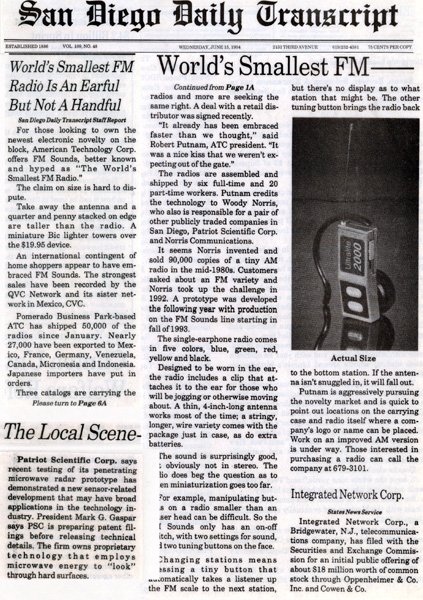
San
Diego Daily Transcript
June 15, 1994

World's Smallest FM Radio Is An Earful But Not a Handful
For those looking to own the newest electronic novelty on the block, American Technology Corp. offers FM Sounds, better known and hyped as "The World's Smallest FM Radio."
The claim on size is hard to dispute.
Take away the antenna and a quarter and penny stacked on edge are taller than the radio. A miniature Bic lighter towers over the $19.95 device.
An international contingent of home shoppers appear to have embraced FM Sounds. The strongest sales have been recorded by the QVC Network and its sister network in Mexico, CVC.
Pomerado Business Park-based ATC has shipped 50,000 of the radios since January. Nearly 27,000 have been exported to Mexico, France, Germany, Venezuela, Canada, Micronesia and Indonesia. Japanese importers have put in orders.
Three catalogs are carrying the radios and more are seeking the same right. A deal with a retail distributor was signed recently.
"It already has been embraced faster than we thought," said Robert Putnam, ATC president. "It was a nice kiss that we weren't expecting out of the gate."
The radios are assembled and shipped by six full-time and 20 part-time workers. Putnam credits the technology to Woody Norris, who also is responsible for a pair of other publicly traded companies in San Diego, Patriot Scientific Corp. and Norris Communications.
It seems Norris invented and sold 90,000 copies of a tiny AM radio in the mid-1980s. Customers asked about an FM variety and Norris took up the challenge in 1992. A prototype was developed the following year with production on the FM Sounds line starting in fall of 1993.
The single-earphone radio comes in five colors, blue, green, red, yellow and black.
Designed to be worn in the ear, the radio includes a clip that attaches it to the ear for those who will be jogging or otherwise moving about. A thin, 4-inch-long antenna works most of the time; a stringy, longer, wire variety comes with the package just in case, as do extra batteries.
The sound is surprisingly good, but obviously not in stereo. The radio does beg the question as to when miniaturization goes too far.
For example, manipulating buttons on a radio smaller than an eraser head can be difficult. So the FM Sounds only has an on-off switch, with two settings for sound, and two tuning buttons on the face.
Changing stations means pressing a tiny button that automatically takes a listener up the FM scale to the next station, but there's no display as to what station that might be. The other tuning button brings the radio back to the bottom station. If the antenna isn't snuggled in, it will fall out.
Putnam is aggressively pursuing the novelty market and is quick to point out locations on the carrying case and radio itself where a company's logo or name can be placed. Work on an improved AM version is under way. Those interested in purchasing a radio can call the company at 679-3101.
CAPTION: Actual Size

|
|
The Local Scene Patriot Scientific Corp. says recent testing of its penetrating microwave radar prototype has demonstrated a new sensor-related development that may have broad applications in the technology industry. President Mark G. Gaspar says PSC is preparing patent filings before releasing technical details. The firm owns proprietary technology that employs microwave energy to "look" through hard surfaces. |
Contact Webmaster
Copyright © 2001-2005 Woody Norris. All rights
reserved.
Revised: September 29, 2005